|
|||||||||
|
ARTICLESThe Rehabilitation–and Appropriation–of Great Wall Mythology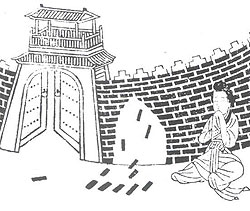 Fig. 1 The legend of Meng Jiangnü, whose lamentations toppled the Great Wall for 800 li of its length, has been included as No.8 on China's Second Listing of Intangible Cultural Heritage. Listed by UNESCO as a World Cultural Heritage property, the Great Wall is undoubtedly China's best-known heritage site (see China Heritage Quarterly, No.6, June 2006, the focus of which was the Great Wall). At the outset of 2006, the State Administration of Cultural Heritage (SACH) also included the legend of Meng Jiangnü, the ancient beauty associated with the Great Wall, on its preliminary list of the nation's intangible cultural heritage items.(Fig. 1) The story is regarded as one of China's 'four great legends', the other three being the tales of White Snake (Baishe), Liang Shanbo and Zhu Yingtai, and the Cowherd and the Weaving Maid (Niulang zhinü). All are included as items on China's list of intangible cultural heritage properties, although the last-named legend only appears on the list through the festival celebrating it, Qixi (the seventh night of the seventh moon) when the Cowherd and Weaving Maid annually meet in Heaven. 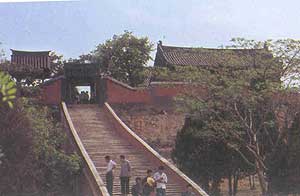 Fig. 2 View of the Temple of Meng Jiangnü at Shanhaiguan, near Qinhuangdao, Hebei province. The legend of Meng Jiangnü might also soon become better-known internationally. In what The Times has described as 'the most ambitious simultaneous worldwide publishing ever attempted', twenty-four international publishing houses have commissioned some of the world's leading authors to re-tell myths and legends from their various cultures. From China, Su Tong was selected as that nation's leading author, and the newly published Bi nu (Emerald Slave) is a fictional version of the Meng Jiangnü legend, his selection from China's repertoire of myths. Su Tong presents his novel as an impassioned and faithful retelling of the tale, stressing that he has not subscribed to the modern Chinese fondness for 'subverting' ancient myths, as exemplified by Lu Xun's Gushi xinbian (Old tales retold). Bi nu will soon appear in translation in 15 countries as part of the international publishing venture first suggested by Scotland's Canongate publishing house in 1999. 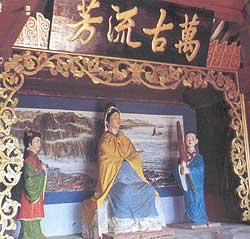 Fig. 3 View of the statue of Meng Jiangnü (with attendants) in temple honouring her at Shanhaiguan, near Qinhuangdao, Hebei province. The legends of Meng Jiangnü are an integral part of China's long tradition of vernacular literature comprising folk songs, dramas and folk tales. Yet only forty years ago, Red Guards destroyed Meng's images in the temple dedicated to her memory at Shanhaiguan, the 'Mountain-and-Sea Pass' adjacent to the Great Wall, (Figs.2, 3) and in the ideological and political battle of the early 1970s designated 'the struggle between Confucianism and Legalism', Meng Jiangnü was vilified by China's propaganda organs as the epitome of a detested Confucian tradition. Countless tracts and other media fare railing against the legend appeared. Today, the 'heritage' of Meng Jiangnü is again lauded, clear testimony to the dramatic turnaround in official attitudes to China's past and her folk literary heritage that has occurred over the last two decades. 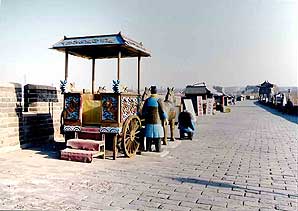 Fig. 4 Commercial photographic booth offering tourists the option of posing in a chariot of Emperor Qin Shihuang. Erected on Great Wall at Shanhaiguan. [Photograph by Cheng Dalin.] Myths accrue around ancient monuments. They explain their genesis - and sometimes their demise. Stonehenge was, for example, once explained as the handiwork of the wizard Merlin and through him the monument became linked to the immense body of Britain's Arthurian and Druidic legends. The Great Wall has an even more enhanced position at the heart of China's current cultural heritage endeavour, yet the mythology surrounding its construction is entangled with Chinese historiography. The role accorded Qin Shihuang in creating a Great Wall for all time forms the solid core of that mythology.(Fig. 4) By contrast, the corpus of 'pure' mythology and literary folklore surrounding the Wall is focused on the legend of Meng Jiangnü, the widow whose lamentations toppled the structure for a length of 800 li, or roughly four hundred kilometres, squarely placing her in diametric opposition to any founding myths. If the mythic historiography of the wall celebrated its construction, the literary mythology associated with the Great Wall celebrated its collapse and in the latter context Qin Shihuang is the villain. The Classic TaleA reasonably standard version of the 'modern' tale of Meng Jiangnü is presented in English in the First Series of Folk Tales of China (Beijing: Foreign Languages Press; 1957). In summary, the legend tells how during the Qin dynasty a young man named Wan Xiliang was pressed into working on the Great Wall, leaving his beautiful and virtuous wife called Meng Jiangnü to pine for him during his absence. Her loathing for Qin Shihuang, the tyrant who had enslaved her husband to labour on the Great Wall, intensified as the separation from her husband grew longer. With the onset of winter Meng Jiangnü grew fearful for her husband who was forced endure the bitter cold of the frozen north. She made padded garments (hanyi) and shoes for him and set out on an epic journey to take him the clothes. She eventually reached the Great Wall, where she saw labourers huddled against the ramparts to shield themselves from the bitter cold winds in a forbidding landscape strewn with corpses. Her anguish grew as her search for her husband proved unsuccessful, until eventually she learned what she had long feared: the back-breaking labour had killed him and he had been buried in the ramparts. She lost consciousness, but when she revived she wept uncontrollably, and those who were with her also wept. So bitter were their lamentations that a length of roughly four hundred kilometres of the Wall collapsed and a violent storm pounded it. When Emperor Qin Shihuang heard that the weeping of a single widow had destroyed a massive section of his Wall, he travelled to see the perpetrator of this outrage for himself. Struck by her exquisite beauty, he pressed her to become his concubine. She saw an opportunity to wreak her revenge so agreed to do so on condition that the emperor fulfil three promises for her: the first, to bury her husband in a golden coffin with a silver lid; the second, to order all his generals and ministers to mourn her husband and attend his funeral; and, the third, to personally attend her husband's funeral and wear deep mourning as a son would do. Having satisfied Meng Jiangnü's requests, the emperor hoped to enjoy the pleasures his new concubine would provide. When Meng Jiangnü saw that her husband had been buried in full conformity with the Rites, she knelt before his tomb and wept. Then she threw herself into a nearby river. The emperor was infuriated and ordered his men to grab her, but before they could do so, she transformed into a beautiful silver fish and swam downstream to freedom. It is interesting to contrast this tale with a version related in a Qing dynasty baojuan text that casts Wan Xiliang's father as a Confucian scholar who is seized by Emperor Qin Shihuang in the repression known as the 'burning of the books and the burial of the Confucians' (fen shu keng ru). Wan's father was a close friend of Meng Jiangnü's father, and so after his father's arrest Wan fled to Meng's home to seek refuge. Setting aside the prototypical tale and its disparate sources, even this fully formed 'classic' version of the tale does not pre-date the Ming dynasty (1368-1644); there are many alternate versions with numerous conflicting details which leave it open to various interpolations. Even the names of the protagonists, apart from Meng Jiangnü and Qin Shihuang, vary from version to version of the 'modern' tale. In some, the natural father of Meng Jiangnü is a simple farmer surnamed Meng; in others the woman is an adopted 'changeling' born in a calabash. While some claim that her husband dies at the wall, in others it is her betrothed. Her hometown also differs from one local literary form to another. In one version common in the Qinhuangdao area the legend of Meng Jiangnü is interwoven with the story of Xiang Yu, the military commander who helped overthrow Qin Shihuang. Various other details of the tale are open to interpretation, or can easily be deleted; moreover, Meng Jiangnü's three demands of Qin Shihuang vary from version to version. However, the salient 'modern' image of Meng Jiangnü is that of the loyal widow of unparalleled beauty whose sorrow destroys the works of the tyrant Qin Shihuang, whose cruelty had caused her husband's death. Meng's wilful opposition to Qin Shihuang, China's founding emperor, may well have earned her respect for her 'revolutionary defiance' during the Maoist era were it not for the fact that Mao Zedong had personally identified himself with that ruler in his poetry. As a result the legend of Meng was subjected to special condemnation as 'reactionary'. Meng Jiangnü SitesThe body of folk literature commemorating Meng Jiangnü is paralleled by the emergence of sites associated with her legend, which seemed to take root wherever it spread, being even found in the mythic repertoire of the Maonan people, a non-Han ethnic group in China's south. Versions of the legend come variously from Shandong, Shaanxi, Shandong, Henan, Hunan, Yunnan, Guangdong, Guangxi, Fujian, Zhejiang and Hebei provinces, as well as in Beijing. The oldest references to the tale, dating from the Warring States period (ended 221 BCE), place her home town in Shandong, which was the cultural centre of 'China' in the pre-Qin period; versions of the tale from the Han to the Tang dynasty, when Xi'an was the major cultural centre, relocate Meng to Shaanxi. The cultural rise of various regions is reflected in the provenance and settings of the different versions. This phenomenon is paralleled by the history of Meng Jiangnü temples. Temples to Meng Jiangnü can be found in Tongchuan, Shaanxi province, in Lixian county, Hunan province, and in Xushui, Hebei province, as well as in Beijing and many other locations in Hebei. The temple dedicated to Meng Jiangnü at Badaling in Beijing casts Meng Jiangnü as a native of the area, a clear demonstration that versions of the tale with this detail emerged in the Ming-Qing period after the Great Wall was constructed there. Today her main temple, described as her 'orthodox site' (zhengzong), is at Shanhaiguan, although its current status as the epicentre of the Meng Jiangnü mythic phenomenon may soon change, as we will later see. According to The Gazetteer of Linyu County, the Meng Jiangnü temple in Qinhuangdao was constructed, , in the period prior to the Song dynasty (960-1279), but it was rebuilt in 1594, during the Wanli reign (1573-1620) of the Ming dynasty. Calligraphy attributed to Xu Wei and poetry by Gu Yanwu, as well as commemorative inscriptions left on the occasion of visits by the Kangxi, Qianlong, Jiaqing and Daoguang emperors of the Qing dynasty, can be found at the site. In 1928, the temple was reconstructed and a statue of Meng Jiangnü installed by the warlord Zhang Xueliang. However, the statues were completely destroyed during the Cultural Revolution; miraculously, the stelae and inscribed poems survived, and the destroyed temple was rebuilt in 1979. To develop the tourist potential of the site, a theme park in what is described as 'the southern Chinese style' was constructed in 1992-93 adjacent to the temple. Among its landmarks are 'the 108 steps' of Meng Jiangnü's final ascent of the Great Wall, pacing out what might be termed her 'stations of the cross'. The entire theme park forms a trajectory of the myth in which the visitor can follow Meng Jiangnü from her hometown, here identified as Mengjiazhuang in Jiangsu province, to her final suicide in the presence of Qin Shihuang, the tyrant. Meng Jiangnü and Modern Folkloric StudiesThe modern study of the Meng Jiangnü tale begins with the birth in the 1920s of China's folk song studies (geyaoxue) and folkloric studies (minsuxue) movements. These had their origins in the late-Qing period, but the documentation of China's folkloric traditions was undertaken as a part of an agenda of national heritage (guogu) studies. Prominent among the early folklorists were pioneers of what were called the New Culture and the Vernacular Literature movements, among whom the most significant figures were Hu Shi, Liu Fu, Zhou Zuoren, Zhong Jingwen and Gu Jiegang. Although these scholars were elitist in their cultural outlook, they were convinced of the primacy of popular and vernacular culture within the overall development of Chinese literature and culture. Their preoccupation with folklore echoed 19th century European developments associated with the rise of nationalism. In the study of the Meng Jiangnü legend, Gu Jiegang (1893-1980) is the leading figure, and his published studies were described by folklorist Zhong Jingwen as 'The Analects of folkloric research'.[1] Gu Jiegang is best remembered as one of the creators of a new school of historiography that sceptically examined the textual layering in the written accounts of ancient history. Central to his examination of the role of folklore within history and the broader culture was his extensive research on the legend of Meng Jiangnü. This went back to the winter of 1922 when he took up a teaching position in Peking University's Department of Guoxue ('National Studies' or Sinology). In the winter of 1923, he published his seminal paper 'Meng Jiangnü gushi de zhuanbian' (The transformation of the story of Meng Jiangnü), and in 1924 Geyao zhoukan (Folksong review) commissioned him to prepare a further paper treating issues associated with the transformation of the legend of Meng Jiangnü. Yet he had not anticipated the wealth of data into which he was tapping; he had only reached the 10th century in his researches when he had already written some 12,000 characters in length. As a result, he had to be content with publishing only the first part of his study in the 69th issue of Folksong review which came off the presses on 23 November 1924 as a special issue devoted to the Meng Jiangnü legend. The article attracted great attention as soon as it appeared, and letters commending the pioneering folkloric work of Gu inundated the journal. Readers from across China also informed the scholar of variants of the Meng Jiangnü legend in various local prose, drama and folk song forms. From Paris, Liu Fu, one of the prime movers of the May Fourth New Culture movement, provided Gu with the texts of the Meng Jiangnü legend that appeared in manuscripts of vernacular literature discovered in the Library Cave at Dunhuang by Paul Pelliot. This unexpected support encouraged Gu to research Meng Jiangnü literature even more fully. In conformity with research as it was then conducted internationally, he isolated mythic themes or universals within the legend as well as particularities of detail, and then outlined a major investigative project with twenty-four topics that examined aspects of the legend through the process of transmission. These topics encompassed the geographical spread of the story, and the particular contours the legend acquired around sites related to the Great Wall, such as the passes at Shanhaiguan and Tongguan, and the northern counties of Tongguan, Xushui and Fengzhou, as well as the unique features the legend assumed in southern China – in Guangdong, Guangxi, Jiangsu and Zhejiang provinces - far from the Great Wall. The wide range of topics he set out to explore included the origins of the custom of presenting padded clothing (hanyi), and the expressed belief in the power of lamentation that can topple an unnatural monument. He also examined exegetically the name of Meng Jiangnü against the background of complex practices of female naming in the Warring States. He would eventually show that Meng Jiangnü was a portmanteau term in the Warring States period for a woman of great beauty. [2] In all, Folksong review published nine issues devoted to Meng Jiangnü, presenting not only Gu's writings but an extensive correspondence and articles on the subject by a number of other scholars and aficionados of folklorica, often with commentary by Gu. This constituted a preliminary round of collective research. A second round of research was initiated by Gu in June 1925. In this second period he no longer simply examined myths and legends in terms of their themes and elements from a historical perspective, but turned to investigate ancient history in light of what the transformations in legends revealed about history itself. Gu Jiegang now treated the Meng Jiangnü legends as an archaeological artefact, and Gu's excavation of the text was a decoding of what the transformations in legends signalled about the societies that gave rise to them. For Gu, Meng Jiangnü now had validity less as mythology than as multi-layered sets of ultimately historical texts; his excavation of the embedded structure of the legend in historical texts ultimately became a study of the underlying structure of ancient society itself as viewed through the accretions in bodies of legend. In 1926 Gu succinctly explained his scholarly approach: 'There are two tasks I wish to undertake: one is to use the outlook of stories (narrative) to explain the elements that structure ancient history, and the other is to provide a systematic account of ancient and modern myths and legends'. [3] From documenting changes in mythology, he turned to examine why mythology changed. Meng Jiangnü is a legend which has developed and changed almost beyond recognition. Most modern variants of the folk tale incorporate some of the following elements and themes: the power of passionate mourning to subvert or destroy the man-made order; the tyranny of Qin Shihuang; the Great Wall; the agony of separation; virtuous chastity; unrequited love; and, unparalleled beauty that has the power to devastate. Unlike many legends, Meng Jiangnü harks back to named historical personages and historical tales. Most scholars follow Gu Jiegang in believing the original Meng Jiangnü to be the wife of the Ji Liang mentioned in a passage in the pre-Qin history Zuo zhuan relating events of the 23rd year of the rule of Duke Xiang, and that the name Ji Liang transformed later into Fan Xiliang, the name of Meng Jiangnü's husband in the modern version of the legend. The brief passage in Zuo zhuan records that after Ji Liang's death in battle, his widow could not accept that the Marquis of Qi had held the mourning ceremony for her husband outside the city walls, a form of commemorative service called the 'suburban mourning' (jiaodiao), and thereby only accorded her the respect due to a concubine, not a wife. Neither the Great Wall nor Qin Shihuang nor Meng Jiangnü appears or is named in this seminal glimpse of the legend. Subsequently, in the text of Tangong, a work of the Warring States period, contained in the ritual text Xiaodai Liji, there is a passage which describes how Ji Liang's wife 'received his coffin by the roadside where she wept piteously'. Lamentation forms the core of the early legend and it is that theme which has enabled researchers to trace the origins of the tale. In the 'Gaozi, xia' section of Mencius, the ability of Ji Liang's wife to weep for her husband 'changed the customs of the nation'.[4] However, even at this time, the legend was not fully formed because the other important element, the 'collapsing walls', had not yet appeared. Gu Jiegang suggested that it was in the Han dynasty, following the articulation by Ying Shao and other philosophers of the theory of the interaction of heaven and man that elements documenting the impact of Meng Jiangnü's lamentations on the natural (mountains) and man-made order (walls) appeared. In some early versions, the mourning of Meng Jiangnü is to have 'toppled the mountain' (bengshan). In two works of the Western Han dynasty and Wei-Jin period, Liu Xiang's Shuo yuan and Lienü zhuan, we begin to find the connection between the mourning for the husband of Ji Liang and the collapse of walls. Later, in the Tang dynasty story Tongxian ji (found in the anthology Diaoyu ji [Carving jade]), Meng's daughter marries a farmer called Ji Liang who has taken refuge on the Meng family estate to avoid being conscripted for hard labour on the Great Wall. After Ji Liang's death on the Great Wall, Meng Jiangnü's 'lamentations toppled the ramparts' (kudao changcheng). Meng Jiangnü's name also appears in a Dunhuang ballad (quzici), underscoring the fact that the fully formed legend had emerged by the Tang dynasty. Who Owns Meng Jiangnü?Gu Jiegang believed that the legend of Meng Jiangnü developed along two lines – as a folk tale and as a scholar's tale. In 1981, on the occasion of the first anniversary of Gu's death, [5] the folklorist Li Zhitian published an article in which he brought a Marxist perspective to bear on Gu's prodigious research into the transformation of the Meng Jiangnü legend. Li simplistically argued that Gu had contrasted a popular transmission that stressed the place of the walls of Qi in the legend and a scholarly transmission of the tale which stressed the place of the walls of Qin in the legend, and presented a table to that effect. [6] Leaving Li's respect for Gu Jiegang aside, Li's motivation in skewing Gu's research was possibly to deliver a backhander to Maoist ideologues by identifying those who had vilified Meng Jiangnü as a Confucian opponent of the Legalist Qin Shihuang with the feudal intellectuals (shidafu) of ancient China who had suppressed the culture of the masses. Shi Aidong, a researcher in the Literature Institute of the Chinese Academy of Social Sciences, and a scholar of Gu Jiegang and the Meng Jiangnü legend, much quoted recently in the press, is opposed to such a simplified rendering of Gu's original research. 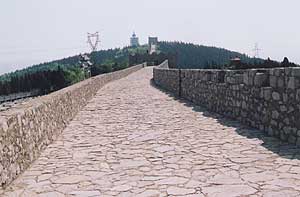 Fig. 5 The original earth ramparts of the great walls of Qi have been destroyed as a result of this fanciful recreation in stone and concrete in the Yuanshan Park in Zibo city, Shandong province. [Photograph by Cheng Dalin, 2004] 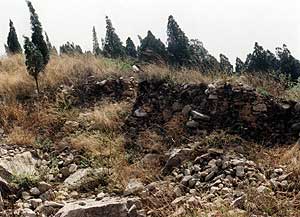 Fig. 6 Untouched remains of the original great walls of Qi that can still be seen in one corner of Yuanshan Park in Zibo city, Shandong province. [Photograph by Cheng Dalin, 2004] Shi writes: 'Wherever the legend spread then the lamentations [of Meng Jiangnü] would topple the walls of that place. Of course, in the story from its beginning the walls of Qi could not have been simply transformed into the walls of Qin, and it is very possible that there many different intervening ramparts. Why haven't these been mentioned in transmitted versions of the tale? Possibly simply because these other ramparts would not widely known and did not form part of any shared body of knowledge'.[7] Strangely, recent press report headlines signalling the listing of the legends of Meng Jiangnü as an item of China's intangible cultural heritage invariably cite Shi Aidong as presenting an original theory that the myth originally referred to the walls of Qi in Shandong, not to the walls of Qin, and that Duke Xiang of Qi not Qin Shihuang was the villain of the tale. A headline from the website of the Nanfang group of newspapers of 8 August 2006 also proclaims: 'Experts Demonstrate Qi Walls Not Qin Walls Toppled by Meng Jiangnü's Weeping'.(Figs.5,6) In the Nanfang account, Wang Pizhuo, deputy curator of the Shandong Provincial Art Gallery, is quoted as saying that, 'In the course of successive emendations and fictional accounts over several dynasties, especially from the Tang dynasty onwards, Meng Jiangnü's mourning for her husband was transformed into her lament at the Great Wall, and her mourning at the great walls [changcheng] of Qi was transformed into her mourning of the great walls of Qin, while the name Ji Liang was eventually orally transmitted as either Wan Xiliang or Fan Xiliang. The influence of the legend gradually spread, but Shandong and Hebei remained the heartland of the transmission'. 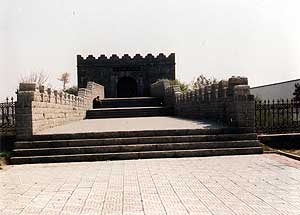 Fig. 7 This site of an ancient fire-beacon tower of the great wall of the Qi state was constructed where the walls reached the ocean. The fanciful reconstruction with anachronistic stone facings of this site has destroyed the original in the Huangdao Development Zone, Qingdao, Shandong province. [Photograph by Cheng Dalin, 2004] This newspaper account also outlines the claims of the city of Zibo in Shandong to the legend of Meng Jiangnü,. Zibo was the successful sole nominator of the legend as item No.8 on both the first and second lists of intangible cultural heritage properties issued by the Chinese Ministry of Culture (see PDF-file lists in this issue). Zibo in Shandong today is best known for its gold, glass and high-tech military industries, but in the vicinity of the city archaeologists have over recent years excavated the remains of Linzi, the walled capital of the ancient state of Qi, and the ancient ramparts of Qi. The walls of Qi are said by some scholars to be China's oldest 'great walls', and the construction of the walls surrounding ancient Linzi is attributed in some accounts to the pre-Qin philosopher Guanzi. [8] The fanciful reconstruction of the ancient city walls and the great wall of the state of Qi in Zibo's Yuanshan Park have resulted in near-total destruction of the original site. However, Zibo is not unique in giving the ancient walls of the state of Qi a complete makeover. Developers in the cities of Qingdao and Zhangqiu (Figs.7-10), also in Shandong province, have also succeeded in destroying much of the remains of the walls of Qi within their jurisdictions. This destruction in Zibo and Shandong province has been well documented for the State Administration of Cultural Heritage by Cheng Dalin, and the few photographs included here are part of a massive archive of several thousand items documenting the history of the Great Walls and the state of their preservation.  Fig. 8 This parking lot for new vehicles in the Huangdao Development Zone, Qingdao, Shandong province, is constructed over the remains of where the Qi walls reached the ocean. [Photograph by Cheng Dalin, 2004] Apart from housing stretches of the walls of the state of Qi, Zibo is moreover located on the Zishui river and in the account of the Meng Jiangnü legend in the late classical novel Dong Zhou lieguo zhi (Tales of the kingdoms of the Eastern Zhou) this is the river in which the widow drowned herself. The report carried by the Nanfang website also stresses the impact the legend has had on the culture of the Zibo region: 'Meng Jiangnü's impassioned lamentations not only had the power to alarm heaven and move the earth but they transformed the customs of the state of Qi, and to the present day in the Zibo area of Shandong middle-aged and elderly women still sing a form of ululation and the traditional songs of Meng Jiangnü are regarded as expressions of mourning. Mengjiang's (sic) crying melodies (kudiao) have spread through the farming villages of the area where they have created a 'lamentation culture' (kudiao).'  Fig. 9 Fanciful concrete reconstruction of the great walls of Qi on site of the original walls in Zhangqiu city, Shandong province. [Photograph by Cheng Dalin, 2004.] 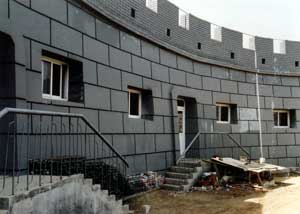 Fig. 10 Close-up of section of the fanciful concrete reconstruction of the great walls of Qi on site of the original walls in Zhangqiu city, Shandong province. [Photograph by Cheng Dalin.] However, Zibo is certainly not crying poor when it comes to cultural heritage. Proclaiming itself a major centre of ancient Chinese culture as the heartland of the culture of Qi, so closely identified with Confucius, the city has nominated a number of intangible cultural heritage items for listing. And the successful nominations on the final list of intangible cultural heritage released by the State Council in May 2006 are: No.53, Liaozhai liqu, the rustic songs of Liaozhai; No.210, wuyin-xi, a local form of operatic drama that features ululating arias; and, last but by no means least, No.299, cuju, ancient Chinese soccer. These items are all problematic, but the latter shows an extraordinary persistence on the part of the officials of Zibo, who now seem poised to emulate Meng Jiangnü by bringing down UNESCO and FIFA. Despite the fact that UNESCO had announced in March 2006 that there would be no further proclamations of items of the world's intangible cultural heritage, officials from Linzi, a town under the jurisdiction of nearby Zibo, announced their bid for recognition of cuju by UNESCO as an item of the world's intangible cultural heritage on 12 September 2006. The officials presented replica cuju soccer balls and books on the ancient game to representatives of UNESCO and the Ministry of Culture who attended the ceremony in Linzi at which their bid was initiated. Xinhua News Agency reported that cuju is 'the oldest form of modern soccer', and that in 2004 FIFA President Sepp Blatter acknowledged Linzi to be 'the birthplace of the sport'. Xinhua added that only later did it spread, along what seems like a peculiar trail of transmission, 'to Egypt, Rome, France and the rest of the world'. Xinhua noted that cuju was a very popular game in the Spring and Autumn period (770-476 BCE) in Linzi, 'one of the largest cities in the world at that time'. Crying only ethnic victimization on this occasion, officials with the Linzi government told Xinhua that 'the game was hard to be revitalized as it had lost popularity during the reign by minorities in the Yuan (1279-1368) and Qing dynasties (1644-1911). And some master-hands who knew how to play the game died without passing the skills on to next generations'. To demonstrate sincerity in fulfilling the stringent criteria of protection and documentation called for by UNESCO and now by the Chinese Ministry of Culture, as well as to account for the disbursement of funds that have flowed from a successful listing as an intangible cultural heritage item, Linzi district has set up cuju courses in urban primary and middle schools. The number of cuju players in Linzi now totals roughly 5,000. Brendan Menton, former general secretary of the Football Association of Ireland and now director of national associations and clubs under the Asian Football Confederation, is quoted by Xinhua as saying, 'We should cheer for cuju, cheer for Linzi. Cuju does not only belong to China, it belongs to all of us. It is the treasure of the world culture' (sic). FIFA, the Football Association of China (CFA) and the Cuju Preservation Association of Kyoto all sent congratulatory letters to Linzi to support its campaign and bid, and cuju teams from Linzi and South Korea also played an exhibition match during the ceremony. Perhaps, in some hypothetical future, when the World Cup is being played out in the Zibo Superdome we might find that Meng Jiangnü has been transformed into the world's first cheer-leader.[BGD] Notes:[1] See Peking University's Forum of Folk Culture Studies website for an online forum on Meng Jiangnü hosted by Shi Aidong, http://www.pkucn.com/chenyc/thread.php?tid=6280 [2] Gu Jiegang's last word on the name of Meng Jiangnü appeared in a co-authored piece. See: Gu Jiegang and Jiang You'an, 'Meng Jiangnü mingcheng de laiyuan' (The origins of the name of Meng Jiangnü), originally published in Minjian wenxue (Folk literature), 1963:3, reproduced in Zhongguo Minjian Wenyi Yanjiuhui, Shanghai Fenhui and Shanghai Wenyi Chubanshe ed., Zhongguo minjian wenxue lunwen xuan, 1949-1979 (Anthology of articles on Chinese folk literature, 1949-1979), Shanghai: Shanghai Wenyi Chubanshe, 1980, 3v., v.3, pp.124-130. [3] Gu Jiegang, 'Xu' (Preface), Gushi bian (Investigations of ancient history), Shanghai: Shanghai Guji Chubanshe, 1981. [4] Meng-zi, 'Gaozi, xia', ch, 6, par. 5. [5] Li Zhitian, 'Gu Jiegang Meng Jiangnü gushi yanjiu shuping: Jinian Gu Jiegang shishi yizhou nian' (An outline assessment of Gu Jiegang's 'research on the story of Meng Jiangnü': In commemoration of the first anniversary of the passing of Gu Jiegang), in Zhong Jingwen ed., Minjian wenyixue wencong (Collected articles on the study of folk literature and art), (Beijing: Beijing Shifan Daxue Chubanshe, 1982), pp.300-314. [6] Ibid., p. 311. [7] Shi Aidong, cited in Li Chan, 'Meng Jiangnü de shenmi miansha liaokai gudai 'jianmei''' (Ripping the veil of secrecy shrouding Meng Jiangnü reveals an ancient 'beauty'), Beijing keji bao (Beijing science and technology news), 21 June 2006 issue, p. 10. [8] Regarding the construction of the 'great walls' of the state of Qi, see: Guo Changhong, 'Qi changcheng zhaojian yuanyin zaitan' (A further discussion of why the construction of the Qi great walls was initiated), Lishi yanjiu (Historical research), 2000:1, esp. pp.184-85. |